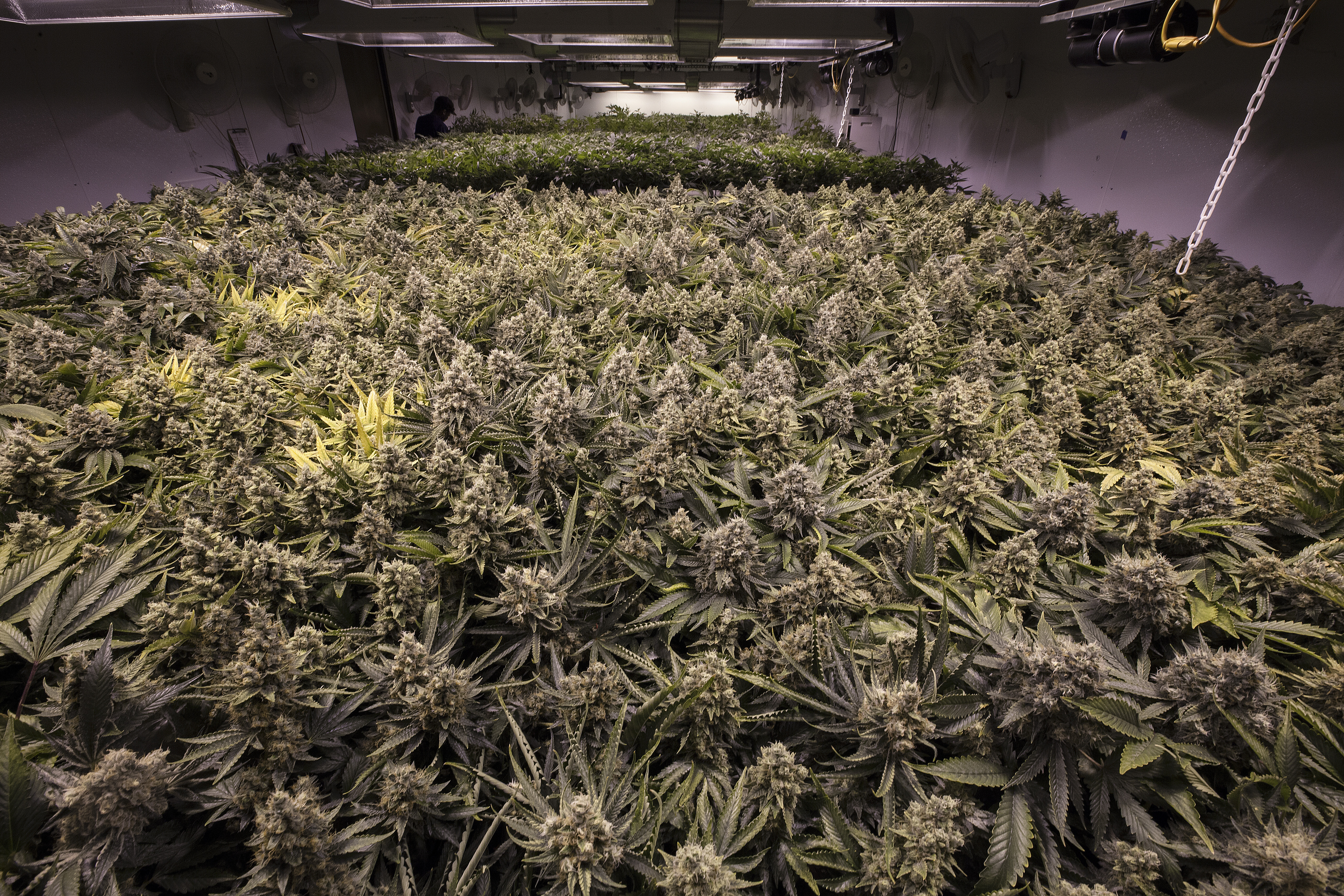Pounds Selling for $900 Wholesale in Oregon

Contrary to a report in Marijuana Business Daily on Jan. 31, marijuana in Oregon’s legal market is not wholesaling for as low as $50 a pound. Prices have fallen dramatically over the past few years, just not that far (yet). The only Oregon weed selling for $50 a pound is leaf that processors buy to convert into oil. The MJ Biz Daily article was corrected shortly after to reflect this, but by then the $50-a-pound story had legs of its own.
There has been a dramatic drop in pot prices since the state began legal sales in 2014. The decline is not surprising; in fact, it was inevitable. Prohibition artificially inflates the price of anything, because of the risk involved and the many hands it touches before reaching the consumer. Legalization reduces risk, so prices naturally decrease at all levels. But there’s more to the story than that.
In Oregon in the late ’80s and early ’90s, thanks to cheap electricity and low rents, the wholesale in-state price of high-grade indoor bud was between $2,000-$2,400 a pound. Outdoors was a little less expensive. After Oregon’s medical-marijuana law was passed in 1998, prices declined gradually. By 2010, top-shelf bud wholesaled for $1,600-$2,000 a pound. Leaf ranged anywhere from free to $10 an ounce at retail.

According to a report from the Oregon Office of Economic Analysis, the wholesale price of marijuana flowers is just over $2 a gram.
Medical-marijuana dispensaries were finally legalized by the Oregon legislature in 2013, with regulations going into full effect the following year—when the state’s voters legalized adult use. That’s when prices started to seriously slide. Four years later, according to a report just issued by the Oregon Office of Economic Analysis, the wholesale price of marijuana flowers in the Beaver State is just over $2 a gram. That works out to around $900 a pound. Pot shops in Portland currently pay anywhere from $300-$1,200 a pound for bud, so the state report’s estimate sounds accurate.
Industry people expect wholesale prices to continue to drop. They also believe that, by next year, there will be fewer people in the business. Some in the industry argue that the reason for these price declines is overproduction, and they have a point. The state makes money on each application it receives and each license it issues, so Oregon has an incentive to expand the number of businesses, regardless of whether they will ever make money.
After auditing the state’s recreational marijuana program, Secretary of State Dennis Richardson reported on Feb. 7: “In 2015, Oregon Liquor Control Commission (OLCC) estimated that there would initially be approximately 800 to 1,300 marijuana-license applicants, based on an analysis of Washington and Colorado trends. Instead, as of December 2017, OLCC had received over 3,100 license applications and had approved over 1,600. Of those, over 50% are for producer licenses to grow marijuana and 31% are for retailer licenses to sell marijuana products. The number of approved applications is expected to reach approximately 2,000 by 2019.”
In Oregon, Washington and Colorado, the analysis adds, “The number of recreational marijuana retailers is about the same, or just over 500. However, once you adjust the numbers based on population, it’s clear that Oregon has significantly more stores. This does not necessarily mean Oregon is over-stored. It may be, but it may also be the case that the other states are under-stored.”
RELATED: MJ Freeway’s Software Dilemma
Zoning laws and other restrictions in the cities and counties in Oregon that allow marijuana businesses—such as the law requiring them to be at least 1,000 feet away from other cannabis enterprises or school property—have the effect of forcing shops to be located relatively near one another. That can give people the illusion that there are a lot of retail stores, though in fact large areas of the state are underserved.
As with other consumer goods, price is a big factor in determining where people shop. Businesses offer specials and discounts, and have to keep margins tight to draw repeat customers. It’s great for consumers, but for businesses and their investors, it’s a nightmare. That price pressure on the retailers is passed along to the growers and processors, forcing their prices lower and lower.

Cannabis grown in Oregon (photo by Doug McVay). Lead photo of Doug McVay by John Sajo.
Oregon Disparity in Diversion Figures
In January, Oregon’s U.S. Attorney Billy J. Williams declared in an op-ed article in The Oregonian, the state’s largest newspaper that “Oregon has a massive marijuana overproduction problem.” He also claimed that legalization has resulted in large quantities of marijuana leaving the state. Oregon has been an exporter of marijuana for decades. How much is actually being diverted to non-legal states, and whether it’s been increasing, is hard to say.
Williams claimed that federal postal inspectors seized 2,644 pounds of pot leaving Oregon in 2017. He compared that with 984 pounds seized by inspectors in Colorado from 2013-2016 to try to show that Oregon was lax. That was misleading: The federal Rocky Mountain High Intensity Drug Trafficking Area report submitted last October concluded that seizures of Colorado cannabis by postal inspectors have increased every year since it was legalized in 2012, with 1,725 pounds seized in 2016.
The industry claims that illegal growers are to blame. After all, legal growers have a legal market. But prices on the legal market are falling fast. Businesses that are losing their shirts still have to satisfy investors, so they’ve got a motive to sell pot outside the system. That’s supposed to be impossible, because the legal market is regulated and there’s oversight. Isn’t it?
The Truth About Seed-to-Sale Tracking Systems
The short answer is, “No.” Secretary Richardson’s audit “identified five issues that increase the risk that OLCC may not detect potential compliance violations or illegal activity. These include relying on self-reported data from marijuana businesses, inconsistent weight measurement systems, allowing untracked marijuana inventory within the first 90 days of operations, poor or insufficient data quality in the [Cannabis Tracking System], and an insufficient number of trained inspectors needed for on-site investigations.”
All states with legal marijuana sales have reporting and tracking requirements— so-called «seed-to-sale» systems. But they all have the same basic flaw: they rely on the honesty of the businesses. In Oregon, growers are required to use RFID chips (Washington allows barcodes). The chip tracks the physical plant, or the physical bags of weed, via GPS. But those chips don’t actually attach themselves to each flower, weigh the usable pot, or track what happens to the plants or the dried marijuana.
Tracking is so difficult that Colorado lawmakers have introduced a bill that would fund research at the University of Colorado to develop a tracking agent, such as a spray, that could be applied directly to marijuana plants. This spray would have to stay on for months as the plant grows, is watered, gets chopped down, dried, trimmed, bagged and sold, and do more than just let regulators track the plant by GPS. As long as it keeps the Feds out, this may be worth looking into to.
“The neoprohibitionists now want to spend more and more of the tax revenue Oregon is collecting from marijuana sales going after the mostly poor people that they have excluded from the market by over regulation,” longtime Oregon activist John Sajo tells Freedom Leaf. “The solution to Oregon (and California) having an oversupply of cannabis is to deschedule cannabis federally, let the states create more inclusive systems and then let the free market sort it out. Spending millions of dollars investigating, arresting, prosecuting and incarcerating people for marijuana will cause pain and suffering, but it will never end the black market as long as there are desperate people who have been left behind.”
RELATED: Oregon Bans Grape Ape and Other Cartoony Strain Names

